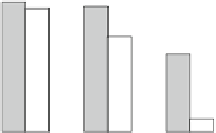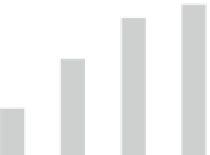Graphics Reference
In-Depth Information
a
b
Hit Rate
Hit Rate
70%
70%
MAU 8x4
MAU 4x8
60%
60%
50%
50%
40%
40%
4KB
8KB
16KB
32KB
64x64
32x32
16x16
Cache size
CTU size
c
Hit Rate
70%
60%
50%
40%
1-way
2-way
4-way
8-way
Cache associativity
Fig. 10.15
Cache hit rate as a function of CTU size, (
a
) cache line geometry, (
b
) cache-size and
(
c
) associativity. Experiments averaged over six sequences—
Basketball Drive, Park Scene, Tennis,
Crowd Run, Old Town Cross
and
Park Joy
. The first are Full HD (240 pictures each) and the
last three are 4K Ultra HD (120 pictures each). CTU size of 64 is used for the cache-size and
associativity experiments
Minimizing Fetch of Unused Pixels.
Since the MAU size is 32 bytes, each access
fetches 32 pixels, some of which may not belong to the current reference region as
seen in Fig.
10.16
. These can be minimized by using an 8
4 MAU to exploit the
rectangular geometry of the reference region. When compared with a 32
1 cache
line this reduces the amount of unused pixels fetched for a given PU by 60 % on
average.
Since the fetched MAU are cached, unused pixels may be reused if they fall
in the reference region of a neighboring PU. Reference MAUs used for prediction at
the right edge of a CTU can be reused when processing CTU to its right. However
the lower CTU gets processed after an entire CTU row in the picture. Due to limited
size of the cache, MAUs fetched at the bottom edge will be ejected and are not
reused when predicting the lower CTU. When compared to 4
8 MAUs, 8
4
MAUs fetch more reusable pixels on the sides and less unused pixels on the bottom.
As seen in Fig.
10.15
a, this leads to a higher hit-rate. This effect is more pronounced
for smaller CTU sizes where hit-rate may increase by up to 12 %.
























